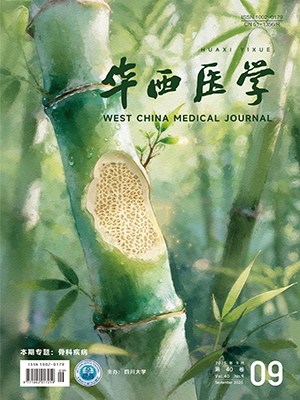| 1. |
Huang K, Yang T, Xu J, et al. Prevalence, risk factors, and management of asthma in China: a national cross-sectional study. Lancet, 2019, 394(10196): 407-418.
|
| 2. |
中華醫學會呼吸病學分會哮喘學組. 支氣管哮喘患者自我管理中國專家共識. 中華結核和呼吸雜志, 2018, 41(3): 171-178.
|
| 3. |
林江濤, 王文巧, 周新, 等. 我國 30 個省市城區門診支氣管哮喘患者控制水平的調查結果. 中華結核和呼吸雜志, 2017, 40(7): 494-498.
|
| 4. |
Bidwal M, Lor K, Yu J, et al. Evaluation of asthma medication adherence rates and strategies to improve adherence in the underserved population at a federally qualified health center. Res Social Adm Pharm, 2017, 13(4): 759-766.
|
| 5. |
尤黎明, 吳瑛. 內科護理學. 6 版. 北京:人民衛生出版社, 2017: 61.
|
| 6. |
周英鳳, 顧鶯, 胡雁, 等. JBI 循證衛生保健中心對關于不同類型研究的質量評價工具—患病率及分析性橫斷面研究的質量評價. 護士進修雜志, 2018, 33(3): 219-221.
|
| 7. |
張冉, 田慶秀, 余麗君. 支氣管哮喘患者吸入糖皮質激素治療依從性的研究. 中華護理雜志, 2015, 50(1): 42-47.
|
| 8. |
劉清華, 陶靜, 胡慧穎, 等. 哮喘患者感知控制力對糖皮質激素吸入治療依從性的影響. 護理學雜志, 2017, 32(5): 27-31.
|
| 9. |
廖麗麗. 成人支氣管哮喘患者吸入糖皮質激素治療依從狀況及影響因素. 中國醫學創新, 2016, 13(12): 52-54.
|
| 10. |
潘巍巍, 李非, 闞麗麗, 等. 成人支氣管哮喘患者吸入糖皮質激素治療的依從狀況及其影響因素. 臨床肺科雜志, 2016, 21(8): 1420-1423.
|
| 11. |
盧紅, 張瑾. 支氣管哮喘患者吸入糖皮質激素治療依從性的研究. 中國社區醫師, 2016, 32(13): 152-153.
|
| 12. |
潘文萍. 支氣管哮喘患者吸入糖皮質激素治療依從性的臨床分析. 飲食保健, 2019, 6(47): 37-38.
|
| 13. |
張小紅. 支氣管哮喘患者吸入糖皮質激素藥物依從性及控制情況的研究. 銀川: 寧夏醫科大學, 2020.
|
| 14. |
施宇衡, 湯葳, 段玉香, 等. 上海地區成人哮喘患者治療依從性的影響因素分析. 國際呼吸雜志, 2019, 39(7): 481-486.
|
| 15. |
陳海莉, 鐘晗, 崔敏, 等. 門診患者使用吸入制劑依從性調查. 醫藥導報, 2019, 38(12): 1661-1664.
|
| 16. |
董正惠. 哮喘患者吸入糖皮質激素治療依從性和控制率影響因素的研究. 烏魯木齊: 新疆醫科大學, 2008.
|
| 17. |
王萌. 支氣管哮喘患者吸入糖皮質激素治療依從性的研究. 醫藥前沿, 2018, 8(21): 107-108.
|
| 18. |
劉建東, 孫曉光. 支氣管哮喘沙美特羅氟替卡松吸入依從性影響因素分析. 中國藥業, 2016, 25(1): 92-94.
|
| 19. |
何登艷, 秦燕. 糖皮質激素吸入治療支氣管哮喘的依從性影響因素及對策. 醫療裝備, 2015(12): 12-13.
|
| 20. |
劉偉. 影響支氣管哮喘激素吸入治療依從性相關因素分析. 醫學綜述, 2013, 19(7): 1309-1310.
|
| 21. |
倪孝慈. 影響支氣管哮喘患者沙美特羅替卡松粉吸入劑治療依從性相關因素分析. 中國處方藥, 2019, 17(11): 57-58.
|
| 22. |
黃可可, 顏志婷, 葉海艷, 等. 哮喘患者用藥依從性的影響因素分析及干預措施探討. 中國現代醫生, 2019, 57(35): 97-99, 113.
|
| 23. |
Plaza V, Giner J, Curto E, et al. Assessing adherence by combining the test of adherence to inhalers with pharmacy refill records. J Investig Allergol Clin Immunol, 2021, 31(1): 58-64.
|
| 24. |
Singh S, Surani S, McGuinness S, et al. Current practice patterns, challenges, and educational needs of asthma care providers in the United States. J Asthma, 2021, 58(8): 1118-1127.
|
| 25. |
Molimard M, Le Gros V, Robinson P, et al. Prevalence and associated factors of oropharyngeal side effects in users of inhaled corticosteroids in a real-life setting. J Aerosol Med Pulm Drug Deliv, 2010, 23(2): 91-95.
|
| 26. |
Ban GY, Trinh TH, Ye YM, et al. Predictors of asthma control in elderly patients. Curr Opin Allergy Clin Immunol, 2016, 16(3): 237-243.
|
| 27. |
Song WJ, Kang MG, Chang YS, et al. Epidemiology of adult asthma in Asia: toward a better understanding. Asia Pac Allergy, 2014, 4(2): 75-85.
|
| 28. |
Gonzalez-Garcia M, Caballero A, Jaramillo C, et al. Prevalence, risk factors and underdiagnosis of asthma and wheezing in adults 40 years and older: a population-based study. J Asthma, 2015, 52(8): 823-830.
|
| 29. |
McQuaid EL. Barriers to medication adherence in asthma: the importance of culture and context. Ann Allergy Asthma Immunol, 2018, 121(1): 37-42.
|
| 30. |
Price D, David-Wang A, Cho SH, et al. Asthma in Asia: physician perspectives on control, inhaler use and patient communications. J Asthma, 2016, 53(7): 761-769.
|
| 31. |
Zolnierek KB, Dimatteo MR. Physician communication and patient adherence to treatment: a meta-analysis. Med Care, 2009, 47(8): 826-834.
|




